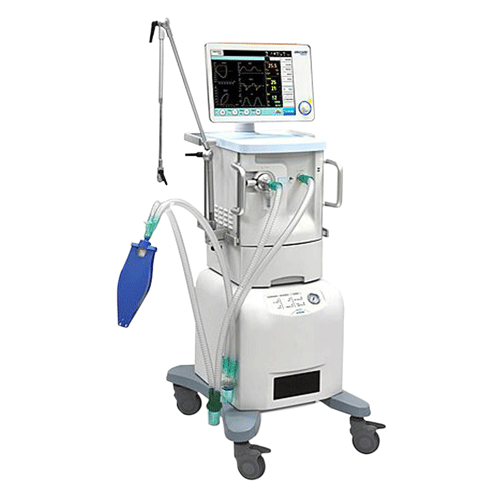Available Results For Ventilator
- Ventilator
- High Flow Oxygen
- Built-in Continuous Oxygen Generation System
- Air Compressor
Ventilator Manufacturers, Suppliers, & Dealers in India
Medical ventilators have become vital tools in patient care, especially during this ongoing epidemic. With an ever-evolving market of medical equipment, choosing the right ventilation device can be challenging for hospital staff. Though, selecting the correct device is vital to enhance patient care, particularly for those with breathing issues.
Why Choosing the Right Ventilator is Significant for Patient Care?
Choosing the right ventilator is vital for enhancing patient care, chiefly for those with respiratory illnesses. The principal function of a ventilator is to support a patient's breathing and oxygenation when they cannot do this effectively on their own. If the ventilator is not matched to the patient's requirements, it could deteriorate their condition, leading to problems, and extending their hospital stay.
Without the correct ventilation support, patients can experience breathing distress, hypoxia, or even respiratory failure. This can lead to severe problems, such as pneumonia, sepsis, and acute respiratory distress syndrome (ARDS). Therefore, selecting the correct ventilator made by the Ventilator Manufacturers, with the right settings and features, can have a noteworthy impact on a patient's outcome.
Kinds of Ventilators
Ventilators are medical machines that support patients' breathing when they are unable to do so on their own. There are numerous different kinds of ventilators, each calculated by Ventilator Manufacturers for precise medical applications. Here is an outline of four common kinds of ventilators:
1. Intensive Care Ventilators: These ventilators are intended for use in intensive care units (ICUs). They typically deliver a high level of respiratory support and can be attuned to meet the requirements of individual patients. Intensive care ventilators are often used for patients who need protracted periods of ventilation.
2. Transport Ventilators: Transport ventilators are intended for use during patient transport. They are lightweight and portable, making them informal to move from one location to another. In addition, they are battery-powered, safeguarding incessant respiratory support even during transport.
3. Neonatal Ventilators: Neonatal ventilators are intended exactly for use with newborn infants. They provide mild, exact respiratory support, making them perfect for premature infants who need care in a neonatal intensive care unit (NICU). Neonatal ventilators are also consumed for infants with respiratory distress syndrome (RDS).
4. Home Ventilators: Home ventilators are intended for use outside of the hospital setting. They are envisioned for patients who require long-term respiratory support at home. Home ventilators are often smaller and less intricate than other kinds of ventilators, making them easier for patients and caregivers to use.
By understanding the different kinds of ventilators obtainable from ventilator suppliers, medical professionals, and caregivers can choose the best device for each patient's exact needs. This guarantees the highest level of breathing support and supports enhance patient outcomes.
When selecting a top ventilator, there are several issues that medical professionals and caregivers need to consider. Here are five key factors that will help guide the decision-making process:
1. Patient requirements: The patient's medical condition and precise respiratory requirements must be prudently evaluated to regulate the kind of ventilator that is best suited for them.
2. Ventilator features: Different ventilators originate with different features, and it's significant to pick a model that has the necessary features to meet the patient's needs. For example, some ventilators are designed for long-term use, while others are more suitable for short-term use.
3. Ease of use: The ventilator's usability and comfort of use are important issues that must be taken into consideration. An easy-to-use ventilator not only hurries up the process of format and alterations but also reduces the risk of errors.
4. Safety features: Ventilators must be safe for patients to use. Therefore, it's significant to look for models that have cutting-edge safety features, such as alarms to alert caregivers of changes in the patient's condition.
5. Maintenance necessities: Ventilators demand steady upkeep, and it's important to pick a model that has a sensible upkeep schedule, compatible with the availability of medical staff, and supplies in the hospital.
By keeping these issues in mind, medical professionals and caregivers can make informed decisions while choosing the top ventilator for a given patient's needs. This will eventually consequence in the highest level of respiratory support, leading to the best patient consequences.
How does one increase the Efficiency of a Ventilator?
1. Guarantee proper setup: Correct setup is crucial for the effective use of a ventilator. Be sure to refer to the ventilator manufacturer's directions and seek guidance from expert medical staff to ensure proper setup.
2. Use appropriate settings: The ventilator settings, including the style, volume, and pressure, must be prudently attuned according to the patient's needs and medical condition.
3. Monitor the patient closely: Regular observation of the patient's vital signs, respiratory rate, and oxygen saturation are significant when using a ventilator. Any changes must be reported directly to the medical staff.
4. Administer humidification: Ventilators can dry out the airways, so directing humidification can help stop problems such as slimy plugging and infections.
5. Teach patients and caregivers: Teaching is key to fruitful ventilator use. Patients and caregivers must be properly skilled in how to use the ventilator, how to recognize potential problems, and what to do in emergencies.
6. Regular maintenance: Regular upkeep of the ventilator, including scrubbing and substituting parts, is important to ensure its permanency and effectiveness. Be sure to follow the ventilator manufacturer's references for maintenance and seek expert help when needed.
By following these tips, medical professionals and caregivers can exploit the use of their selected ventilator and provide the best possible care for their patients.
The hospital product directory is a complete guide that provides detailed information on different medical equipment and devices available on the market. It is a valuable resource for hospital staff, particularly those involved in selecting equipment for patient care. Using this directory, hospitals can make knowledgeable decisions and ensure they are selecting the right equipment to optimize patient outcomes.
1. Acquaint Yourself with Terminology: The directory comprises many technical terms and verbiage associated with ventilators. It is important to have a basic understanding of these terms before searching for equipment.
2. Determine Your Specific Needs: Before starting your search, regulate the specific needs of your patients and facility. This includes factors like patient age, medical history, and the available resources in your facility.
3. Compare and Contrast: The hospital product directory includes thorough specifications and features of different ventilator models. It is significant to associate and contrasts different options before making a final decision.
4. Consider Funds and Logistics: When choosing a ventilator, it is important to consider the budget, logistics, and obtainability of maintenance and support services. These issues can influence the overall effectiveness and efficiency of the equipment.
By understanding the hospital product directory and using it effectively, hospitals can maximize patient care by selecting the best ventilators available on the market. Providing the best conceivable care for patients is of utmost importance. Investing in the right equipment, like ventilators, can support medical professionals and caregivers achieve this goal. By carefully choosing the top ventilators using the hospital product directory and following the tips for exploiting their use, medical professionals can ensure that their patients receive optimal care and support. It is also important to arrange regular upkeep of the equipment to ensure its longevity and efficiency. Ultimately, advancing in high-quality equipment plays a critical role in providing the best possible care for patients, and should be a top priority for all healthcare providers.





